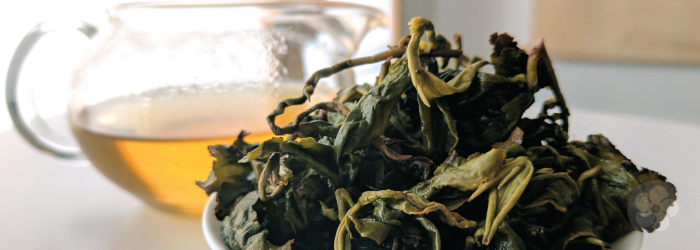What is Royal Courtesan Tea?

Among the poetic English names given to Chinese teas, Royal Courtesan is a relative newcomer. According to legend, the leaves of this bug bitten oolong had the grace and poise of an imperial concubine, inspiring the name. But as with Milk Oolong, or any other generalized tea name, “Royal Courtesan” doesn’t offer much information about the tea you’re drinking. Vague labels like this are often used to increase the perceived value of mediocre tea.
Typically, Royal Courtesan describes a Taiwanese oolong that has been attacked by leafhoppers. These indigenous insects induce a defensive reaction in the plant, which begins to produce a variety of new chemical compounds. These new compounds change the flavor and aroma of the leaf, giving the finished tea a “honey fragrance” or mi xiang. Care in harvesting and crafting these leaves is essential. Leaves with too much damage will tend toward bitterness, and mi xiang teas are often more oxidized than their unblemished counterparts in order to emphasize the honeyed fragrance of the leaves.

As the story goes, this type of tea originated in 2000, after a large earthquake disrupted the harvest season and the leaves were left vulnerable to leafhopper bites. But other bug-bitten teas, including Oriental Beauty, have been around since the earliest days of Taiwanese tea exports. The distinguishing feature is where the tea is grown. Oriental Beauty, grown at low elevations at the far north of the island, is more vulnerable to leafhoppers due to warmer temperatures. By contrast, Royal Courtesan teas come from Tung Ting, where higher elevations make bug bites less common.
This combination of factors naturally limits the quantity of such tea that can be produced. Bugs must bite at the right time in the right density to produce the desired effect, and it is difficult to craft a tea like this with consistency from year to year. As with any popular style, imitations are sure to abound. This is where a vague name like Royal Courtesan can breed confusion. Teas under this name could be bitten by different insects, which produce different chemical compounds in the plant. They could be sourced from lower elevations, or even completely different regions, and the name “Royal Courtesan” would give no hint to the average tea drinker.

Instead, we prefer to use more specific names that offer factual information about the tea. We do, in fact, carry a tea harvested on Tung Ting, and bitten by leafhoppers before plucking. We call this tea Tung Ting, Mi Xiang, to describe both the provenance and the bug bitten harvest.
Sign up for our newsletter to get blog updates in your inbox!



Comments on this post (0)